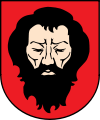Trakai
| Trakai | ||
|---|---|---|
| City | ||

Bridge and Castle of Trakai
|
||
|
||
| Location of Trakai | ||
| Coordinates: 54°38′0″N 24°56′0″E / 54.63333°N 24.93333°ECoordinates: 54°38′0″N 24°56′0″E / 54.63333°N 24.93333°E | ||
| Country |
|
|
| Ethnographic region | Aukštaitija | |
| County | Vilnius County | |
| Municipality | Trakai district municipality | |
| Eldership | Trakai eldership | |
| Capital of |
Trakai district municipality Trakai eldership |
|
| First mentioned | 1337 | |
| Granted city rights | 1409 | |
| Population (2010) | ||
| • Total | 5,266 | |
| Time zone | EET (UTC+2) | |
| • Summer (DST) | EEST (UTC+3) | |
Trakai (![]() Trakai ) (see names section for alternate and historic names) is a historic city and lake resort in Lithuania. It lies 28 kilometres (17 miles) west of Vilnius, the capital of Lithuania. Because of its proximity to Vilnius, Trakai is a popular tourist destination. Trakai is the administrative centre of Trakai district municipality. The town covers 497.1 square kilometres (191.9 square miles) of area and, according to 2007 estimates, is inhabited by 5,357 people. A notable feature of Trakai is that the town was built and preserved by people of different nationalities. Historically, communities of Karaims, Tatars, Lithuanians, Russians, Jews and Poles lived here.
Trakai ) (see names section for alternate and historic names) is a historic city and lake resort in Lithuania. It lies 28 kilometres (17 miles) west of Vilnius, the capital of Lithuania. Because of its proximity to Vilnius, Trakai is a popular tourist destination. Trakai is the administrative centre of Trakai district municipality. The town covers 497.1 square kilometres (191.9 square miles) of area and, according to 2007 estimates, is inhabited by 5,357 people. A notable feature of Trakai is that the town was built and preserved by people of different nationalities. Historically, communities of Karaims, Tatars, Lithuanians, Russians, Jews and Poles lived here.
The name of the town was first recorded in chronicles from 1337 in German as Tracken (later also used spelling Traken) and is derived from the Lithuanian word trakai (singular: trakas meaning a glade). Since the time of the Polish–Lithuanian Commonwealth, the city was known as Troki in Polish. Its other alternate names include Trok (Yiddish), Troky, and Traki.
The majority of Trakai's inhabitants (66.5%) are Lithuanian, although the town also has a substantial Polish minority (19%), as well as Russians (8.87%). The city has a significant Karaite population.
...
Wikipedia


